 Web Front-end
Web Front-end H5 Tutorial
H5 Tutorial HTML5 history new features pushState, replaceState and the difference between the two _html5 tutorial skills
HTML5 history new features pushState, replaceState and the difference between the two _html5 tutorial skillsThe window object in the DOM provides access to browser history through the window.history method, allowing you to move forward and backward in the user's access record.
Starting with HTML5, we can start manipulating this history stack.
1. History
Use the back(), forward(), and go() methods to move forward in the user's history and Back
Forward and Back
Back:
window.history.back();
This method will act like the user clicked the back key on the browser toolbar.
Similarly, the following method can also be used to generate user forward behavior:
window.history.forward();
Move to a specific position in the history
You can use go() Method loads a specific page from session history.
Move one page backward:
window.history.go(-1);
Move forward one page:
window.history.go(1);
Similarly, you can move forward or Go back multiple pages.
You can also find the total number of pages in the history stack by checking the length property of the browser history.
var numberOfEntries = window.history .length;
Note: IE supports passing URL parameters to the go() method.
2. Add and modify history entities
Introduced since Gecko2 (Firefox 4 / Thunderbird 3.3 / SeaMonkey 2.1)
HTML5 introduced the two methods history.pushState() and history.replaceState(), which allow adding and modifying history entities. At the same time, these methods will work with the window.onpostate event.
Use the history.pushState() method to modify the referrer. This method can be used in the http header created for the xmlhttpRequest object after modifying the state. This referrer will be the URL of the document when creating the XMLHttpRequest.
pushState is used to add the record of the current page to history, while replaceState is used exactly the same as pushState. The only difference is that it is used to modify the record of the current page in history.
Example
Suppose http://mozilla.org/foo.html page executes JS
var stateObj = { foo: "bar" }; history.pushState(stateObj, "page 2", "bar.html ");
This method will cause the URL address bar to display http://mozilla.org/bar.html, but the browser will not load the bar.html page, even if this page exists.
Now again assume the user continues to http://google.com and clicks back. At this time, the url address bar will be, http://mozilla.org/bar.html, and the page will get the popstate event (chrome). This state object will contain a copy of stateObj. This page looks like foo.html.
At this time, we click back again, the URL will become http://mozilla.org/foo.html, and the document will get another popstate event and a null state object. This return action does not change the content of the document. (Maybe try loading...chrome after a while)
pushState method
pushState() has three parameters: state object, title (now is ignored and not processed), URL (optional). Specific details:
· state object – The state object is a JavaScript object, which is related to the new history entity created by the pushState() method. Used to store information about the entry you want to insert into the history. State object can be any Json string. Because Firefox will use the user's hard disk to access the state object, the maximum storage space of this object is 640k. If it is greater than this value, the pushState() method will throw an exception. If you really need more space for storage, use local storage.
· title—firefox now ignores this parameter, although it may be used in the future. The safest way to use it now is to pass an empty string to prevent future modifications. Or you can pass a short title to represent state
· URL—This parameter is used to pass the URL of the new history entity. Note that the browser will not load this URL after calling the pushState() method. But maybe it will try to load this URL after a while. For example, after the user restarts the browser, the new URL may not be an absolute path. If it is a relative path, it will be relative to the existing url. The new url must be in the same domain as the existing url, otherwise pushState() will throw an exception. This parameter is optional. If it is empty, it will be set to the current URL of the document.
In a sense, calling the pushState() method is very similar to setting window.location = "#foo". Both of them will create and activate another history entity associated with the current document, but pushState() )There are also some advantages:
The new url can be any url in the same domain as the current url. In contrast, if you only set the hash, window.location will remain in the same document.
You don’t need to modify the url if you don’t need to. In contrast, setting window.location = "#foo"; only generates a new history entity. If your current hash is not #foo
you can associate arbitrary data with your new history entity. Using hash-based methods, all relevant data needs to be encoded into a short string.
Note that the pushState() method will not cause the hashchange time to occur, even if the old and new URLs only have different hashes.
replaceState() method
history.replaceState() is used much like pushState(), except that replaceState() is used to modify the current history entity instead of creating a new one. This method is sometimes useful. When you need to update a state object or the current history entity in response to certain user actions, you can use it to update the state object or the URL of the current history entity.
popstate event
When the history entity is changed, the popstate event will occur. If the history entity is generated by pushState and replaceState methods, the state attribute of the popstate event will contain a copy of the state object from the history entity
For details, see window.onpopstate
Read the current state
Read existing state
When the page loads, it may have a non-empty state object. This may happen when the user restarts the browser after the page sets a state object (using pushState or replaceState). When the page reloads, the page will receive the onload event, but there will be no popstate event. However, if you read the history.state property, you will get the state object after the popstate event occurs
var currentState = history.state;
Browsers: Tested and Working In
HTML5 Browsers
Chrome 8,9,10
Firefox 4
Safari 5
Opera 11
Safari iOS 4.3
HTML4 Browsers
IE6,7,8,9
Firefox 3
Opera 10
Safari 4
Safari iOS prior to version 4.3
pushState and replaceState Difference
history.pushState(state, title, url)
--------------------- -------------------------------------------------- ---------
Add the current URL and history.state to history, and replace the current one with the new state and URL. It will not cause the page to refresh.
state: State information corresponding to the URL to be jumped to.
title: 전달할 필요가 없습니다.
url: 이동할 URL 주소, 도메인을 넘을 수 없습니다.
history.replaceState(상태, 제목, URL)
------------- ------------------------------------------------ --
현재 상태와 URL을 새 것으로 바꿉니다. 페이지가 새로 고쳐지지는 않습니다.
state: 이동할 URL에 해당하는 상태 정보입니다.
제목: 전달할 수 없음
url: 이동할 URL 주소, 도메인을 넘을 수 없음.
------------------------------- ------ ----------
그런 것 같아요 둘 사이에는 차이가 없지만 실제로 가장 큰 차이점은 pushState가 기록 레코드를 추가하는 반면, replacementState는 그렇지 않다는 것입니다.
 html5的div一行可以放两个吗Apr 25, 2022 pm 05:32 PM
html5的div一行可以放两个吗Apr 25, 2022 pm 05:32 PMhtml5的div元素默认一行不可以放两个。div是一个块级元素,一个元素会独占一行,两个div默认无法在同一行显示;但可以通过给div元素添加“display:inline;”样式,将其转为行内元素,就可以实现多个div在同一行显示了。
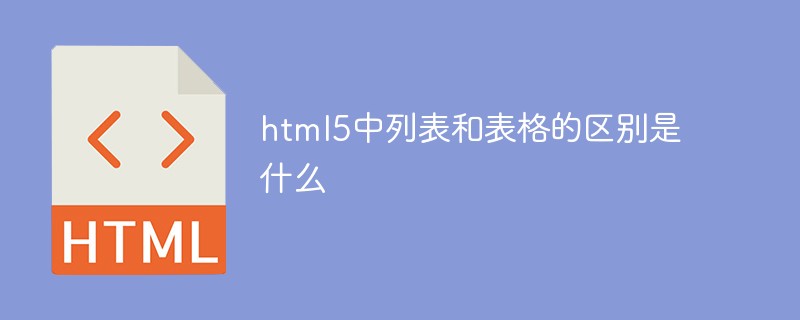 html5中列表和表格的区别是什么Apr 28, 2022 pm 01:58 PM
html5中列表和表格的区别是什么Apr 28, 2022 pm 01:58 PMhtml5中列表和表格的区别:1、表格主要是用于显示数据的,而列表主要是用于给数据进行布局;2、表格是使用table标签配合tr、td、th等标签进行定义的,列表是利用li标签配合ol、ul等标签进行定义的。
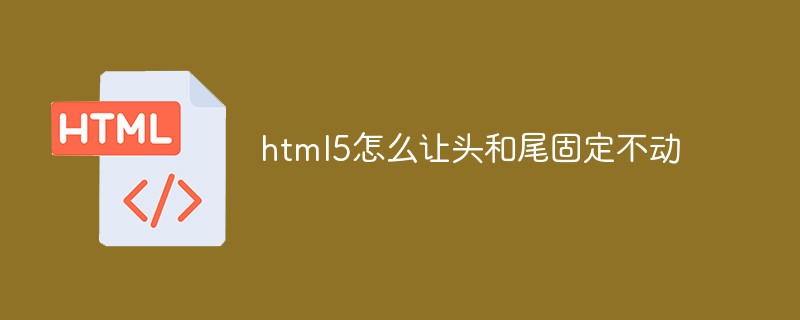 html5怎么让头和尾固定不动Apr 25, 2022 pm 02:30 PM
html5怎么让头和尾固定不动Apr 25, 2022 pm 02:30 PM固定方法:1、使用header标签定义文档头部内容,并添加“position:fixed;top:0;”样式让其固定不动;2、使用footer标签定义尾部内容,并添加“position: fixed;bottom: 0;”样式让其固定不动。
 HTML5中画布标签是什么May 18, 2022 pm 04:55 PM
HTML5中画布标签是什么May 18, 2022 pm 04:55 PMHTML5中画布标签是“<canvas>”。canvas标签用于图形的绘制,它只是一个矩形的图形容器,绘制图形必须通过脚本(通常是JavaScript)来完成;开发者可利用多种js方法来在canvas中绘制路径、盒、圆、字符以及添加图像等。
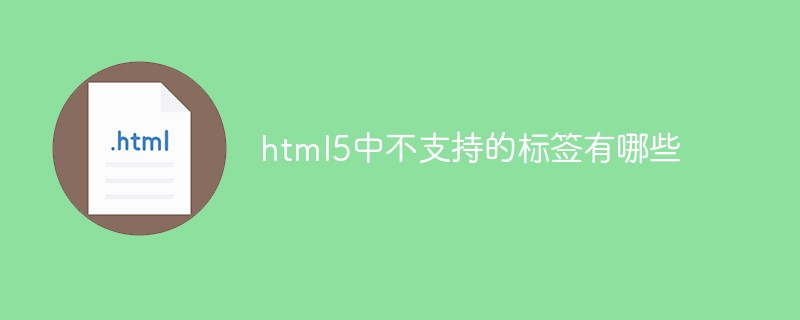 html5中不支持的标签有哪些Mar 17, 2022 pm 05:43 PM
html5中不支持的标签有哪些Mar 17, 2022 pm 05:43 PMhtml5中不支持的标签有:1、acronym,用于定义首字母缩写,可用abbr替代;2、basefont,可利用css样式替代;3、applet,可用object替代;4、dir,定义目录列表,可用ul替代;5、big,定义大号文本等等。
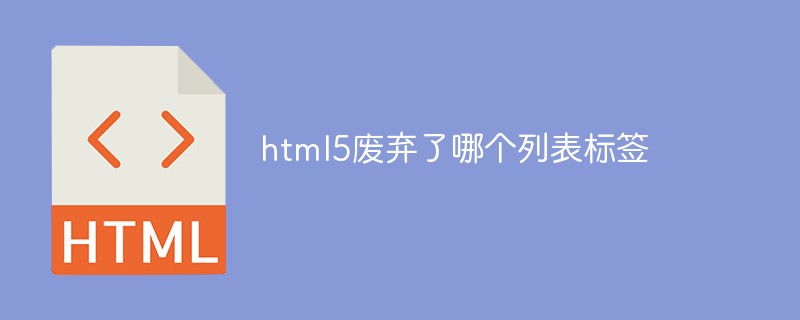 html5废弃了哪个列表标签Jun 01, 2022 pm 06:32 PM
html5废弃了哪个列表标签Jun 01, 2022 pm 06:32 PMhtml5废弃了dir列表标签。dir标签被用来定义目录列表,一般和li标签配合使用,在dir标签对中通过li标签来设置列表项,语法“<dir><li>列表项值</li>...</dir>”。HTML5已经不支持dir,可使用ul标签取代。
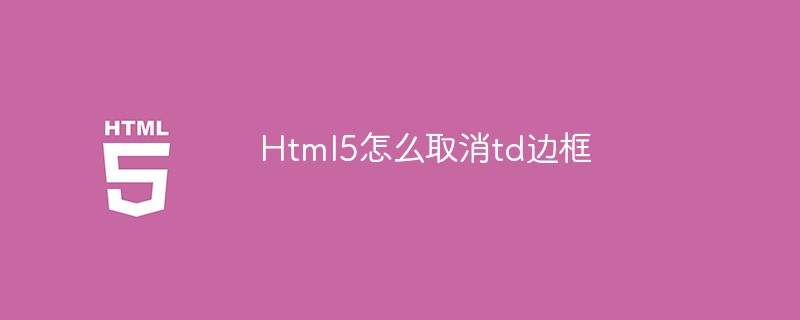 Html5怎么取消td边框May 18, 2022 pm 06:57 PM
Html5怎么取消td边框May 18, 2022 pm 06:57 PM3种取消方法:1、给td元素添加“border:none”无边框样式即可,语法“td{border:none}”。2、给td元素添加“border:0”样式,语法“td{border:0;}”,将td边框的宽度设置为0即可。3、给td元素添加“border:transparent”样式,语法“td{border:transparent;}”,将td边框的颜色设置为透明即可。
 html5为什么只需要写doctypeJun 07, 2022 pm 05:15 PM
html5为什么只需要写doctypeJun 07, 2022 pm 05:15 PM因为html5不基于SGML(标准通用置标语言),不需要对DTD进行引用,但是需要doctype来规范浏览器的行为,也即按照正常的方式来运行,因此html5只需要写doctype即可。“!DOCTYPE”是一种标准通用标记语言的文档类型声明,用于告诉浏览器编写页面所用的标记的版本。


Hot AI Tools

Undresser.AI Undress
AI-powered app for creating realistic nude photos

AI Clothes Remover
Online AI tool for removing clothes from photos.

Undress AI Tool
Undress images for free

Clothoff.io
AI clothes remover

AI Hentai Generator
Generate AI Hentai for free.

Hot Article

Hot Tools

SublimeText3 English version
Recommended: Win version, supports code prompts!

DVWA
Damn Vulnerable Web App (DVWA) is a PHP/MySQL web application that is very vulnerable. Its main goals are to be an aid for security professionals to test their skills and tools in a legal environment, to help web developers better understand the process of securing web applications, and to help teachers/students teach/learn in a classroom environment Web application security. The goal of DVWA is to practice some of the most common web vulnerabilities through a simple and straightforward interface, with varying degrees of difficulty. Please note that this software

mPDF
mPDF is a PHP library that can generate PDF files from UTF-8 encoded HTML. The original author, Ian Back, wrote mPDF to output PDF files "on the fly" from his website and handle different languages. It is slower than original scripts like HTML2FPDF and produces larger files when using Unicode fonts, but supports CSS styles etc. and has a lot of enhancements. Supports almost all languages, including RTL (Arabic and Hebrew) and CJK (Chinese, Japanese and Korean). Supports nested block-level elements (such as P, DIV),

Notepad++7.3.1
Easy-to-use and free code editor

PhpStorm Mac version
The latest (2018.2.1) professional PHP integrated development tool





